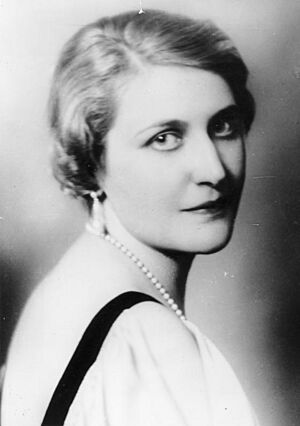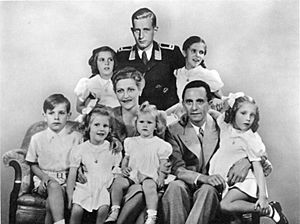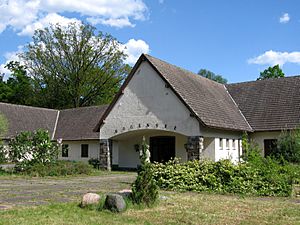Magda Goebbels facts for kids
Quick facts for kids
Magda Goebbels
|
|
|---|---|

Goebbels in 1933
|
|
| Personal details | |
| Born |
Johanna Maria Magdalena Ritschel
11 November 1901 Berlin, German Empire |
| Died | 1 May 1945 (aged 43) Führerbunker, Berlin, Nazi Germany |
| Cause of death | Suicide |
| Political party | Nazi Party (NSDAP) |
| Spouses | |
| Children | Harald, Helga, Hildegard, Helmut, Holdine, Hedwig, Heidrun |
| Alma mater | Ursuline Convent |
| Awards | Golden Party Badge Cross of Honor of the German Mother |
Johanna Maria Magdalena "Magda" Goebbels (née Ritschel; 11 November 1901 – 1 May 1945) was the wife of Nazi Germany's Propaganda Minister Joseph Goebbels. A prominent member of the Nazi Party, she was a close ally, companion, and political supporter of Adolf Hitler. Some historians refer to her as the unofficial "first lady" of Nazi Germany, while others give that title to Emmy Göring.
Contents
Early life
Magda was born in 1901 in Berlin, Germany, to an unwed couple, Auguste Behrend and building contractor and engineer Oskar Ritschel. The couple were married later that year and divorced in either 1904 or 1905. Some sources claim their marriage took place before Magda's birth, although there is no evidence to support the occurrence of a prior wedding. When Magda was five, her mother sent her to Cologne to stay with her ex-husband. In 1908, her mother married Richard Friedländer, a wealthy Jewish merchant who lived in Brussels, and adopted Magda to give her his surname. In Brussels, Magda was enrolled at the Ursuline Convent in Vilvoorde where she was remembered as "an active and intelligent little girl". Further contacts with Ritschel, a member of the Krefeld Masonic Lodge in Duisburg, suggest that Magda may have been introduced there to Buddhism.
In 2016, it was reported that Friedländer may have been Magda's biological father, as stated in his residency card, found in the Berlin archives by writer and historian Oliver Hilmes. Magda's adoption may have been required for her parents' delayed marriage, to update the girl's 'illegitimate child' status.
From 1908 until the outbreak of World War I, the family remained in Brussels. In 1914, all Germans were forced to leave Belgium as refugees to avoid repercussions from the Belgian people after the German invasion. The family moved to Berlin where Magda attended the high school Kolmorgen Lycée. Behrend divorced Friedländer in 1914, and in 1919, Magda was enrolled in the prestigious 'Töchternheim Holzhausen' (Ladies' College Holzhausen) near Goslar. While in Berlin, Magda befriended Lisa Arlosoroff and later became intimate with her brother Haim, an ardent Zionist. During her relationship with Haim, she briefly wore a Star of David he had given her and accompanied him to Jewish youth club meetings. The relationship did not last but the two remained in contact during the 1920s until Haim's migration to Mandatory Palestine, where he later headed the Jewish Agency department.
Marriage and son with Günther Quandt
In 1920, while returning to school on a train, she met Günther Quandt, a rich German industrialist twice her age. Thereafter, he courted her with courtesy and grand gestures. He demanded that she change her surname back to Ritschel (after having for many years borne the surname of Friedländer), when converting from Catholicism to Quandt's Protestantism. They were married on 4 January 1921, and their first child, Harald, was born on 1 November 1921.
Magda soon grew frustrated in her marriage; Quandt spent little time with her, as his main interest was the expansion of his business empire. The couple had six children – Harald, Quandt's two sons from a prior marriage, and three children of a deceased friend.
In October 1927, the couple went on a two-month visit to the United States, to conduct business with the Lloyd Electric Storage Battery Co. of Philadelphia. In 1929, they separated and divorced later in the year. The terms of the divorce were quite generous to Magda.
Marriage and family with Joseph Goebbels

In 1930, Magda attended a meeting of the Nazi Party where she was impressed by one of the speakers, Joseph Goebbels, then the Gauleiter of Berlin. She joined the party on 1 September 1930, and did some volunteer work, although she has not been characterized as politically active. From the local branch, Magda moved to the party headquarters in Berlin and for a brief period became secretary to Hans Meinshausen, Goebbels' deputy, before being invited to take charge of Goebbels' own private papers. She and Goebbels became romantically involved while on a short trip with friends to Weimar in February 1931. A relationship began and by April they began making plans for their future together. Goebbels wrote in his diary, "We have made a solemn vow to each other: When we have conquered the Reich, we will become man and wife. I am very happy." Her flat on Theodor-Heuss-Platz (then named the Reichskanzlerplatz) soon became a favourite meeting place for Adolf Hitler and other NSDAP officials.
By September, the Goebbels relationship was experiencing problems. Goebbels was often jealous, and had some concern over the fact that Hitler had grown fond of Magda. Magda decided to advance their wedding date, and the couple were married on 19 December 1931, with Hitler as a witness. Otto Wagener claims that Magda's marriage to Goebbels was somewhat arranged; since Hitler intended to remain unmarried, it was suggested that as the wife of a leading and highly visible Nazi official she might eventually act as "first lady of the Third Reich". Magda was an ambitious woman with social connections and upper class bearing that may have influenced Goebbels' own enthusiasm. Hitler grew very fond of the Goebbels' six children and enjoyed staying at their Berlin apartment, where he could relax and would often arrive there late at night, sitting and talking with Goebbels, with their baby Helga (born 1932) on his lap.

Magda had thus a close relationship with Hitler, and became a member of his small coterie of female friends. She acted as an unofficial representative of the regime, receiving letters from all over Germany from women with questions about domestic matters or child custody issues. After 1933, the Goebbels family became accustomed to the luxurious lifestyle which went with their high social position. Their Berlin home on Göringstrasse was remodeled by Albert Speer and they spent the spring and summers in Kladow. In 1936, they bought a villa on Schwanenwerder island and later another at Bogensee near Wandlitz in Brandenburg.
Joseph and Magda Goebbels had six children: Helga (1932), Hilde (1934), Helmut (1935), Holde (1937), Hedda (1938), and Heide (1940).
War years
At the outbreak of war, Magda's son by her first marriage, Harald Quandt, became a Luftwaffe pilot and fought at the front, while, at home, she lived up to the image of a patriotic mother by training as a Red Cross nurse and working with the electronics company Telefunken, and travelled to work on a bus, like her colleagues. She was also involved with entertaining the wives of foreign heads of state, supporting the troops and comforting war widows.
Both Goebbels and Magda derived personal benefits and social status from their close association with Hitler, and the couple remained loyal to Hitler and publicly supported him. Privately, however, Magda expressed doubts, especially after the war began to go badly on the Eastern Front. On 9 November 1942, during a gathering with friends listening to a speech by Hitler, she switched off the radio exclaiming, "My God, what a lot of rubbish." In 1944, she reportedly said of Hitler, "He no longer listens to voices of reason. Those who tell him what he wants to hear are the only ones he believes." There is no evidence that Magda attempted to intervene to save her Jewish stepfather from the Holocaust. Though his fate has not been established, it is widely assumed that he perished in the camps. Asked about her husband's antisemitism, she answered: "The Führer wants it thus, and Joseph must obey."
Felix Franks, a German Jew who later became a British soldier, claimed that his grandparents got an exit visa from Germany with the help of Magda Goebbels:
My father and step-mother were left behind in Germany but, two days before the War started, they were asked to come to Gestapo Headquarters and given an exit visa. There is a story in the family which goes back to the First World War when my step-grandparents were asked to give shelter to a young woman who'd been displaced by the war in Belgium. Although she had a Jewish step-father, she eventually married Joseph Goebbels! My stepmother believes she may have acted as a sort of protecting hand and was involved with the exit visa. Certainly, the night before Kristallnacht, they got an anonymous phone call warning my father not to go home that evening but to go somewhere safe. My step-mother swore it was Magda Goebbels.
Afflicted with a weak heart and "delicate health", Magda would have extended periods of illness. Towards the end of the war, she is known to have also suffered from severe depression and trigeminal neuralgia. This condition affects a nerve in the face, and although usually harmless is considered to cause intense pain and can be notoriously hard to treat. This often left her bedridden and led to bouts of hospitalization as late as August 1944.
Death
In late April 1945, the Soviet Red Army entered Berlin, and the Goebbels family moved into the Vorbunker, connected to the lower Führerbunker under the Reich Chancellery garden. Magda wrote a farewell letter to her son Harald, who was in a POW camp in North Africa:
Harald! My beloved son! By now we have been in the Führerbunker for six days already—daddy, your six little siblings and I, for the sake of giving our national socialistic lives the only possible honourable end ... You shall know that I stayed here against daddy's will, and that even on last Sunday the Führer wanted to help me to get out. You know your mother—we have the same blood, for me there was no wavering. Our glorious idea is ruined and with it everything beautiful and marvelous that I have known in my life. The world that comes after the Führer and national socialism is not any longer worth living in and therefore I took the children with me, for they are too good for the life that would follow, and a merciful God will understand me when I will give them the salvation ... The children are wonderful ... there never is a word of complaint nor crying. The impacts are shaking the bunker. The elder kids cover the younger ones, their presence is a blessing and they are making the Führer smile once in a while. May God help that I have the strength to perform the last and hardest. We only have one goal left: loyalty to the Führer even in death. Harald, my dear son—I want to give you what I learned in life: be loyal! Loyal to yourself, loyal to the people and loyal to your country ... Be proud of us and try to keep us in dear memory ...
Goebbels added a postscript to Hitler's last will and testament of 29 April stating that he would disobey the order to leave Berlin, "[f]or reasons of humanity and personal loyalty". Further, he stated that Magda and their children supported his refusal to leave Berlin and his resolution to die in the bunker.
Magda was among the last to see both Hitler and Eva Braun before they committed suicide on the afternoon of 30 April. On the following day, 1 May, Magda and Joseph arranged for SS dentist Helmut Kunz to inject their six children with morphine so that when they were unconscious, an ampule of cyanide could be then crushed in each of their mouths. After their children were dead, Magda and Joseph Goebbels walked up to the garden of the Chancellery, where they committed suicide.
See also
 In Spanish: Magda Goebbels para niños
In Spanish: Magda Goebbels para niños


